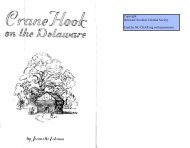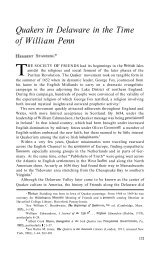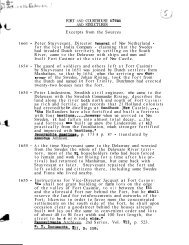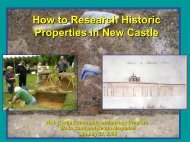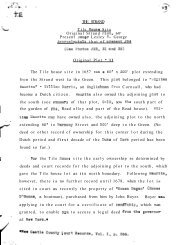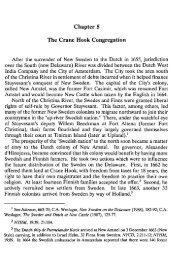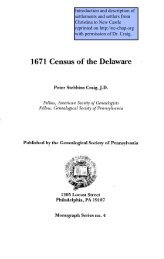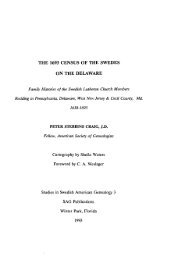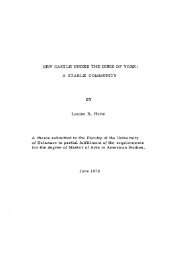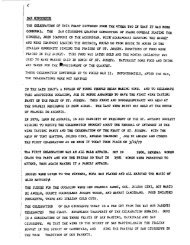The Forest Finns as Transmitters of Finnish Culture ... - NC CHAP
The Forest Finns as Transmitters of Finnish Culture ... - NC CHAP
The Forest Finns as Transmitters of Finnish Culture ... - NC CHAP
You also want an ePaper? Increase the reach of your titles
YUMPU automatically turns print PDFs into web optimized ePapers that Google loves.
<strong>The</strong> <strong>Forest</strong> <strong>Finns</strong> <strong>as</strong> <strong>Transmitters</strong> <strong>of</strong> <strong>Finnish</strong><br />
<strong>Culture</strong> From Savo Via Central Scandinavia<br />
to Delaware<br />
JUHA PENTIKAINEN<br />
"Nova Suecia eller the Swensk<strong>as</strong> Revier in India Occidentali" is the title<br />
<strong>of</strong> the famous map that Peter Lindestrom drew for his Geographia Amer-<br />
icae.' New Sweden is, <strong>of</strong> course, historically the correct name <strong>of</strong> the col-<br />
ony founded in 1638 under the auspices <strong>of</strong> the Swedish Crown. However,<br />
people <strong>of</strong> <strong>Finnish</strong> origin played a crucial role in the colony from the very<br />
beginning. <strong>The</strong> main owners <strong>of</strong> the New Sweden trading company formed<br />
in 1637 were Axel Oxenstierna <strong>of</strong> Queen Christina's court and the Fin-<br />
nish-born Admiral Klaus Fleming.2<br />
Swedish and <strong>Finnish</strong> history are, <strong>of</strong> course, interrelated. Finland w<strong>as</strong> a<br />
part <strong>of</strong> Sweden from the period <strong>of</strong> the Crusades-<strong>of</strong>ficially since 1216,<br />
when the pope promised Finland to the King <strong>of</strong> Sweden-until 1809,<br />
when Finland w<strong>as</strong> ceded to the Russian Empire <strong>as</strong> an autonomous grand<br />
duchy. During Queen Christina's reign (1632-54) the bonds between Fin-<br />
land and Sweden were friendly. Per Brahe, the governor general <strong>of</strong> Fin-<br />
land (1637-40 and 1648-54), influenced <strong>Finnish</strong> cultural and economic<br />
life by founding the Turku Academy (now the University <strong>of</strong> Helsinki) in<br />
1640, by establishing trade connections across the Gulf <strong>of</strong> Bothnia, and<br />
by founding several new towns along the <strong>Finnish</strong> co<strong>as</strong>t. Swedish re-<br />
mained the <strong>of</strong>ficial language <strong>of</strong> <strong>Finnish</strong> cultural, social, and economic life<br />
until the latter part <strong>of</strong> the nineteenth century.<br />
<strong>The</strong> history <strong>of</strong> New Sweden h<strong>as</strong> generally been written from the Swed-<br />
ish point <strong>of</strong> view for two re<strong>as</strong>ons. First, when Amandus Johnson pub-<br />
lished his monumental work <strong>The</strong> Swedish Settlements on the Delaware in<br />
two volumes in 1911, he scarcely emph<strong>as</strong>ized the role <strong>of</strong> the <strong>Finns</strong> on<br />
the various expeditions and gave no references for the origins <strong>of</strong> the Fin-<br />
nish colonist^.^ This is not surprising because Finland w<strong>as</strong> not an inde-<br />
pendent country when Johnson's work appeared. Second, most <strong>of</strong> the
<strong>Finns</strong> who settled in New Sweden had not moved directly from Finland<br />
but had spent several decades in central Scandinavia. During that time<br />
many changed their <strong>Finnish</strong> names to Swedish or Norwegian ones, a practice<br />
that h<strong>as</strong> caused considerable trouble for those studying the background<br />
<strong>of</strong> the <strong>Finnish</strong> colonists. However, in the oldest records <strong>of</strong> New<br />
Sweden, it w<strong>as</strong> usual to indicate <strong>Finnish</strong> origin by adding "the Finn" <strong>as</strong><br />
in "Anders Andersson the Finn," "Anders the Finn," "Evert the Finn,"<br />
"L<strong>as</strong>se the Finn," and so on.4<br />
Thus it is difficult to identity the first <strong>Finnish</strong> colonists in New Sweden.<br />
According to <strong>Finnish</strong> tradition canonized by <strong>Finnish</strong> author A. Jarnefelt-<br />
Rauenheimo (1861-1932), the first commander <strong>of</strong> Fort Christina, Lieutenant<br />
Miins Nilsson Kling, w<strong>as</strong> a Finn.5 It is known that he spoke <strong>Finnish</strong><br />
because one <strong>of</strong> his <strong>as</strong>signments w<strong>as</strong> to recruit <strong>Finnish</strong>-speaking immigrants<br />
from central Scandinavia to New Sweden. Solomon Ilrnonen, the<br />
historian <strong>of</strong> the American <strong>Finns</strong>, mentions three <strong>Finns</strong> who participated<br />
in the second expedition <strong>of</strong> the Kalmar Nyckel: the seaman Lars Andersson<br />
from the Aland Islands; the soldier Maunu Andersson; and Peter<br />
Rambo, a soldier who had escaped from military ~ervice.~ Estimates <strong>of</strong><br />
the number <strong>of</strong> <strong>Finns</strong> who came to Delaware vary from source to source.<br />
According to some estimates, the majority (from 50 to 75 percent) <strong>of</strong> seventeenth-century<br />
settlers in New Sweden were <strong>Finns</strong>. Ilmonen found 295<br />
<strong>Finns</strong> in the lists <strong>of</strong> immigrants who moved to New S~eden.~<br />
While living in central Scandinavia, many <strong>Finnish</strong> people probably became<br />
bilingual. Pr<strong>of</strong>essor Pehr Kalm (1716-79), a scientist from the<br />
Turku Academy who lived briefly in the area <strong>of</strong> the former New Sweden<br />
in the mid-eighteenth century, found no <strong>Finnish</strong> speakers. Because the<br />
"<strong>of</strong>ficial" language <strong>of</strong> the colony w<strong>as</strong> Swedish, the first <strong>Finnish</strong> generation<br />
had to learn that language. Swedish retained a certain preeminence<br />
in the Delaware Valley in the eighteenth century due to the influence <strong>of</strong><br />
Lutheran ministers who continued to be sent to Delaware from Sweden.'<br />
Thus it can be said that colonists with <strong>Finnish</strong> origins became Americanized<br />
via Scandinavian languages.<br />
An <strong>as</strong>pect <strong>of</strong> the yet-unwritten history <strong>of</strong> the first Scandinavian coloni-<br />
zation <strong>of</strong> the New World concerns the <strong>Forest</strong> <strong>Finns</strong>, mets<strong>as</strong>uomalaiset in<br />
<strong>Finnish</strong>, skogsfinnarna in Swedish. It is, therefore, important to study<br />
their cultural history in the Old World to understand the role they<br />
played <strong>as</strong> part <strong>of</strong> the first Scandinavian colonization in the New World.<br />
<strong>The</strong> term <strong>Forest</strong> Finn w<strong>as</strong> probably coined by Swedish and Norwegian<br />
farmers living in the river valleys <strong>of</strong> central Scandinavia to describe the
<strong>Finnish</strong>-speaking people who settled the neighboring forest are<strong>as</strong>. Ac-<br />
cording to historical sources, most <strong>of</strong> these newcomers came from Savo,<br />
a <strong>Finnish</strong> district located far from the sea and isolated from the capital <strong>of</strong><br />
Sweden.' From the Middle Ages until the sixteenth century Savo w<strong>as</strong> the<br />
border province between Finland (that is, Sweden) and Russia. <strong>The</strong>re<br />
were successive wars between the two kingdoms in 1493-95, 1555-67,<br />
1570-95, 1609-17, 1656-61, 1700-21, 1741-43, 1788-90, and 1808-9.<br />
<strong>The</strong> boundary, first drawn in 1323 by the Treaty <strong>of</strong> Pahkinansaari, w<strong>as</strong><br />
confusing because the treaty boundary w<strong>as</strong> also designated <strong>as</strong> the boun-<br />
dary between two religions: the Roman Catholic and the Russian Ortho-<br />
dox. During the course <strong>of</strong> history the Catholics-after the Lutheran Re-<br />
formation, the Protestants-were to live on the Swedish side while the<br />
Orthodax believers were to live on the Russian side <strong>of</strong> the border. Every<br />
new negotiation meant obligatory population movements across the<br />
boundary, either to the west or to the e<strong>as</strong>t. In some c<strong>as</strong>es completely<br />
new <strong>Finnish</strong> settlements were formed far outside <strong>of</strong> Finland.<br />
In religious terms the people in Savo belonged to the Catholic/Protes-<br />
tant part <strong>of</strong> the population and were obliged to move several times. Dur-<br />
ing the Middle Ages the forest area <strong>of</strong> St. Michael w<strong>as</strong> the center <strong>of</strong><br />
settlement and the economy w<strong>as</strong> b<strong>as</strong>ed on local forest resources. It<br />
combined hunting, fishing, berry-picking, tar-burning, and cattle breed-<br />
ing. But above all, the most distinctive <strong>Finnish</strong> activity w<strong>as</strong> the use <strong>of</strong><br />
burn-beating methods for cultivating the land. When the <strong>Finns</strong> first<br />
moved to central Scandinavia, their way <strong>of</strong> life w<strong>as</strong> nomadic or semino-<br />
madic because the resources they used were available in different re-<br />
gions during different se<strong>as</strong>ons. However, even after people had settled<br />
down, the <strong>Forest</strong> <strong>Finns</strong> were obliged to move periodically because their<br />
agricultural methods depleted resources within two or three generations.<br />
Medieval sources state that Karelian pe<strong>as</strong>ants moved every ten or twenty<br />
years.'' Thus an integral <strong>as</strong>pect <strong>of</strong> their life-style w<strong>as</strong> the willingness to<br />
migrate when necessary.<br />
Gustav V<strong>as</strong>a w<strong>as</strong> the first Swedish king (1523-60) to recognize the pos-<br />
itive political effect that the <strong>Forest</strong> Finn economy might have on a cen-<br />
tralized government. <strong>The</strong> Lutheran Reformation and the settlement <strong>of</strong><br />
the wilderness in the <strong>Finnish</strong> regions <strong>of</strong> northern Savo, Hame, Sata-<br />
kunta, and Karelia, <strong>as</strong> well <strong>as</strong> Kainuu, were completed during his reign.<br />
His principle w<strong>as</strong> that all wilderness belonged to the Crown and could<br />
be distributed to new settlers who would then become taxpayers. People<br />
from Savo who spoke an e<strong>as</strong>tern <strong>Finnish</strong> dialect formed the majority <strong>of</strong><br />
newcomers in what is now central and e<strong>as</strong>tern Finland. Most moves<br />
across the borders <strong>of</strong> Savo Province were voluntary; nevertheless, migra-<br />
tion w<strong>as</strong> strongly encouraged by the Crown during Gustav V<strong>as</strong>a's reign<br />
and on into the seventeenth century. <strong>The</strong>se moves promised economic
advantages to the immigrants. When problems arose between the new-<br />
comers and the longtime occupants <strong>of</strong> the wilderness, the solutions<br />
usually benefited the newcomers. For this re<strong>as</strong>on the original residents,<br />
the Saami people and their reindeer, were pushed north beyond the cir-<br />
cumpolar zone in Finland. A similar fate befell those <strong>Finns</strong> who preferred<br />
hunting and fishing to permanent agricultural settlements.<br />
During this same period, the Crown and the Lutheran church orga-<br />
nized local administrations in the wilderness. <strong>The</strong>y built churches and<br />
founded extensive parishes like Rautalampi, where people speaking<br />
Savo dialects were in the majority. It w<strong>as</strong> from this area that the primary<br />
<strong>Finnish</strong> immigration took place to the forests <strong>of</strong> Varmland and its neigh-<br />
boring provinces in central Scandinavia during the sixteenth and seven-<br />
teenth centuries.<br />
At the 1987 Nordic Symposium, Kauko Pirinen, pr<strong>of</strong>essor emeritus <strong>of</strong><br />
the University <strong>of</strong> Helsinki, discussed the people who formed important<br />
links between the Crown and the emigrants from Savo. Gustav V<strong>as</strong>a<br />
had given Gustav Fincke, the commander <strong>of</strong> Savonlinna C<strong>as</strong>tle, the t<strong>as</strong>k<br />
<strong>of</strong> engaging men from Savo to build fortresses in Sweden during the<br />
1540s and 1550s." Thus in the latter half <strong>of</strong> the sixteenth century several<br />
men from Savo worked in different capacities in Stockholm C<strong>as</strong>tle. How-<br />
ever, the great immigration to the forests in Varmland did not occur by<br />
way <strong>of</strong> the capital <strong>of</strong> the country; it w<strong>as</strong> a direct continuation <strong>of</strong> the pre-<br />
viously described moves.<br />
<strong>The</strong> first document about immigration across the Gulf <strong>of</strong> Bothnia to<br />
Sweden is in an appeal to King Johan I11 in 1578, which stated that sev-<br />
eral soldiers and other men conscripted for the war between Sweden and<br />
Russia (1570-95) had been obliged to leave the country with their famil-<br />
ies for other are<strong>as</strong>.12 <strong>The</strong> migration continued despite a war that l<strong>as</strong>ted<br />
twenty-five years and a king who opposed it. <strong>The</strong> movement seems to<br />
have been led by Duke Carl (later King Carl IX, 1550-1611), who, for<br />
political and economic re<strong>as</strong>ons, encouraged the pe<strong>as</strong>ants from Savo to<br />
move to the central Scandinavian forests. It is likely that his chamber sec-<br />
retary, Mins Jonson Auvinen, who came from Sulkava parish in Savo,<br />
acted <strong>as</strong> the necessary link coordinating the early waves <strong>of</strong> immigration<br />
at the end <strong>of</strong> the sixteenth century.13<br />
Encouraging immigration from Savo to the uninhabited forest are<strong>as</strong> on<br />
the border <strong>of</strong> Sweden and Norway became the policy <strong>of</strong> the Crown dur-<br />
ing the reigns <strong>of</strong> Carl IX and Gustav I1 Adolf (1611-32). Most <strong>of</strong> this<br />
immigration took place between 1600 and 1620, and the number <strong>of</strong> the
<strong>Finnish</strong> people who came and remained in central Scandinavia exceeded<br />
ten thousand.<br />
<strong>The</strong> once huge parish <strong>of</strong> Rautalampi in Savo is <strong>of</strong>ten mentioned in lit-<br />
erary and historical sources <strong>as</strong> the main point <strong>of</strong> departure for <strong>Finnish</strong><br />
immigrants14 to the Swedish province <strong>of</strong> Varmland.15 This is only par-<br />
tially true. As the ethnologist Richard Broberg h<strong>as</strong> shown in his careful<br />
studies <strong>of</strong> the roots <strong>of</strong> the newcomers and their settlements, the immi-<br />
grants originated from a much wider area <strong>of</strong> Finland and settled in many<br />
provinces. <strong>The</strong>y formed an almost unified belt from Angermanland and<br />
Jamtland to the lake area in central Sweden.16<br />
<strong>The</strong> districts that the <strong>Finnish</strong> newcomers inhabited are called <strong>Finns</strong>ko-<br />
gen (Finn forests) in Swedish, and, <strong>as</strong> mentioned above, the people them-<br />
selves are termed skogsfinnarna (<strong>Forest</strong> <strong>Finns</strong>). Both names refer to a<br />
specific way <strong>of</strong> life and form <strong>of</strong> culture. To non-<strong>Finns</strong> the forest w<strong>as</strong> the<br />
natural environment for the <strong>Finns</strong> and the main focus <strong>of</strong> their culture<br />
since they were thought to be perfectly adapted to the ways <strong>of</strong> forest<br />
life. When <strong>Finns</strong> from Savo, Kainuu, and central Finland came to central<br />
Scandinavia, they found surroundings that, at le<strong>as</strong>t ecologically, were<br />
very much like their native lake country in Finland. Both the old and<br />
new milieus included hills and slopes, lakes and streams. In the new en-<br />
vironment these <strong>Finns</strong> could practice the same combined economy to<br />
which they were accustomed.<br />
In the new are<strong>as</strong> were virgin forests for burn-beating cultivation,<br />
huuhta, and k<strong>as</strong>ki, a woodland path cleared by cutting trees and brush<br />
and then burning the debris. <strong>The</strong>se are the special sl<strong>as</strong>h-and-burn tech-<br />
niques <strong>of</strong> cultivation that the <strong>Finns</strong> brought with them first to Sweden<br />
and then to the New World, <strong>as</strong> historian Per Martin Tvengsberg, a de-<br />
scendant <strong>of</strong> <strong>Forest</strong> <strong>Finns</strong>, h<strong>as</strong> shown in his studies.17 This type <strong>of</strong> econ-<br />
omy brought good harvests-many times more than what w<strong>as</strong> sowed-<br />
but also meant a short-term use <strong>of</strong> the resources. It took two or three<br />
generations (sixty to eighty years) before an area could be used again in<br />
this manner.<br />
People coming from Savo used a special technique (described by<br />
Tvengsberg), different from other <strong>Finns</strong>, when practicing huuhta and<br />
burning k<strong>as</strong>ki.18 As a result they were exceedingly efficient in utilizing<br />
the forest resources for agricultural purposes. <strong>The</strong>y were not poor pe<strong>as</strong>-<br />
ants; rather they were rich farmers who traded their harvests <strong>as</strong> far away<br />
<strong>as</strong> the co<strong>as</strong>tal towns <strong>of</strong> Sweden and even abroad. <strong>The</strong>y used the same<br />
wooden tools for agriculture that they had made in Finland.
Another important use <strong>of</strong> forest resources w<strong>as</strong> tar burning, a c<strong>as</strong>h crop<br />
for the <strong>Forest</strong> <strong>Finns</strong>. In addition they kept the same domestic animals<br />
they had in Finland: cows, horses, pigs, and sheep. Hunting, fishing,<br />
berry- and mushroom-picking were carried on much the same way <strong>as</strong><br />
they were in Finland.<br />
A common story is told by the <strong>Forest</strong> <strong>Finns</strong> about a Finn who migrated<br />
a long time ago:<br />
He had an axe and a sickle in his bag and some salt. He also had a small bag<br />
made out <strong>of</strong> a bird's skin and some barley there. He had another bag <strong>of</strong> bark<br />
when he went hunting in his forest. He immediately started to make his<br />
"huuhta," to bum it down when it w<strong>as</strong> ready. He built his sauna and then the<br />
smoke house. And sometimes the Swedes came and wanted to send him back<br />
where he had come from.lg<br />
This story could also describe the experience <strong>of</strong> the many <strong>Finns</strong> who<br />
responded to a new appeal from the Crown to sail to the colony in America.<br />
<strong>The</strong> <strong>Finnish</strong> population had incre<strong>as</strong>ed <strong>as</strong> rapidly in Scandinavia <strong>as</strong> it<br />
previously had in Savo. In Scandinavia the <strong>Finns</strong> and the native inhabitants<br />
had quarreled from the beginning over rights to land and its use<br />
for the <strong>Finnish</strong> type <strong>of</strong> culti~ation.~~ <strong>The</strong> statute <strong>of</strong> 1647 that prohibited<br />
<strong>Finnish</strong> sl<strong>as</strong>h-and-burn cultivation, with the exception <strong>of</strong> making new<br />
fields, coincided with the active mission <strong>of</strong> encouraging <strong>Forest</strong> <strong>Finns</strong> to<br />
move overse<strong>as</strong>. <strong>The</strong>y left in great numbers, particularly in the 1650s,<br />
when about two hundred <strong>Finns</strong> went to America in a single boat. In<br />
fact, on the twelfth expedition to New Sweden in 1655, many more than<br />
the ninety-two <strong>Finns</strong> who were accepted at the harbor <strong>of</strong> Goteborg had<br />
wanted to go. <strong>The</strong> leader <strong>of</strong> this expedition, Lieutenant J. Papegoja, felt<br />
it "both sorrowful and shameful that they could not be taken along. For<br />
these people, disappointed in their hopes, had sold their property for<br />
nothing, they had used their resources for the long journey to the co<strong>as</strong>t,<br />
and now had to take up a begging staff and go on unknown ways, such a<br />
cry and weeping began <strong>as</strong> can seldom be heard.""<br />
When those who had been fortunate enough to be selected finally arrived<br />
in America, they learned that the New Sweden colony already belonged<br />
to the Dutch. <strong>The</strong> Dutch permitted the immigrant members <strong>of</strong> the<br />
expedition to remain, but the crew and the soldiers had to return to Sweden.<br />
This expedition had, however, started such a great "American fever"<br />
among the <strong>Forest</strong> <strong>Finns</strong> that many <strong>of</strong> them tried to move to America<br />
during the following decade. Thirty-two people finally succeeded in<br />
arriving at Delaware in 1663, and another group <strong>of</strong> 140 arrived in 1664<br />
via Am~terdam.~~ <strong>The</strong>se people are e<strong>as</strong>ier to identify <strong>as</strong> <strong>Finns</strong> because<br />
they kept their original names.
Oral tradition about this first "American fever" h<strong>as</strong> survived until re-<br />
cently among the <strong>Forest</strong> <strong>Finns</strong> <strong>of</strong> Central Sweden. Thus the Swedish<br />
priest E. G. Fryxell, who collected material on the <strong>Forest</strong> <strong>Finns</strong> from 0s-<br />
mark in Varmland, reported in 1889 to Albrekt Segerstedt, writer and<br />
collector <strong>of</strong> folktales, that "perhaps the first <strong>Finns</strong> and Swedes to move<br />
to America during Queen Christina's time came from here."23 Because<br />
<strong>of</strong> this "American fever," <strong>Finnish</strong> people from Varmland and the neigh-<br />
boring provinces left for America when new opportunities arose, in the<br />
process nearly emptying <strong>Forest</strong> Finn villages in Sweden and Norway.<br />
Two important elements in the definition <strong>of</strong> a <strong>Forest</strong> Finn are the eco-<br />
logical environment <strong>of</strong> forests and "<strong>Finnish</strong>ness" itself. It is possible to<br />
reconstruct the culture and worldview <strong>of</strong> those men and women who left<br />
Savo and the neighboring provinces in Finland to move to central Scandi-<br />
navia-and then after from one to three generations in Scandinavia to<br />
move on to Delaware.<br />
<strong>The</strong>ir language w<strong>as</strong> <strong>Finnish</strong>. More strictly speaking, it w<strong>as</strong> a dialect<br />
called "Savo," very different from western <strong>Finnish</strong>, which is the b<strong>as</strong>is for<br />
the literary <strong>Finnish</strong> language. Many <strong>of</strong> its archaisms have been preserved<br />
in the central Scandinavian forests until modern times-a survival <strong>of</strong><br />
more than ten generations. Some speakers <strong>of</strong> this dialect still live in the<br />
<strong>Finnish</strong> forests. Maintaining such a linguistic tradition in formal oral com-<br />
munication is quite rare anywhere in the world today.<br />
A culture that survives in this kind <strong>of</strong> isolation, surrounded by another<br />
language, tends to be quite conservative, including its manifestations <strong>of</strong><br />
material culture. This is especially true in the traditional set <strong>of</strong> buildings,<br />
for example, including the smoke house (savupirtti), threshing barn (riihi),<br />
tools, furniture, hunting weapons, and fishing implements. Interestingly<br />
enough, the sauna h<strong>as</strong> almost disappeared from the area due to the activ-<br />
ity <strong>of</strong> the Lutheran ministers. <strong>The</strong> clergy considered the sauna a manifes-<br />
tation <strong>of</strong> witchcraft; it w<strong>as</strong> too barbaric for men and women to bathe<br />
naked together.<br />
Segerstedt wrote in his 1889 report that <strong>Finns</strong> in general were religious<br />
and devout people,24 active and faithful members <strong>of</strong> the established<br />
church. He also praised their honesty, but at the same time felt that the<br />
<strong>Finns</strong> did not care enough for religious education in their homes. In his<br />
opinion they too <strong>of</strong>ten practiced witchcraft because even without that<br />
mystic way <strong>of</strong> behavior, they had succeeded financially.<br />
Early folklore collectors were able to find many other archaic elements<br />
<strong>of</strong> ancient <strong>Finnish</strong> culture among the <strong>Forest</strong> <strong>Finns</strong>. <strong>The</strong>y were particularly
capable in charms, incantations, and other expressions <strong>of</strong> witchcraft. <strong>The</strong>y<br />
surely practiced shamanism, archaic trance techniques, during which the<br />
soul <strong>of</strong> the shaman left the body. <strong>The</strong> shaman w<strong>as</strong> called tietaja, a man <strong>of</strong><br />
knowledge. He w<strong>as</strong> the leader <strong>of</strong> the society and could occupy temporarily<br />
the status <strong>of</strong> healer, judge, and clergyman. Even in the twentieth century<br />
the <strong>Forest</strong> <strong>Finns</strong> can give quite thorough descriptions about the wedding<br />
<strong>of</strong> the bear-a multi-episodic drama in the course <strong>of</strong> which the bear<br />
w<strong>as</strong> killed and then sent to his celestial home in the star <strong>of</strong> the Great<br />
Dipper or Otava, and then returned <strong>as</strong> the totem animal worshiped by<br />
the clan.<br />
Segerstedt w<strong>as</strong> also interested in the folk music <strong>of</strong> the <strong>Finns</strong>. <strong>The</strong>y<br />
played the violin and two types <strong>of</strong> native stringed instruments, kantele,<br />
and had their own special melodies. Later research h<strong>as</strong> shown that traditions<br />
<strong>of</strong> folk music and dance have undergone change though some <strong>Finnish</strong><br />
songs, tunes, and dances still continue. Savo people living in central<br />
Scandinavian forests were able to sing old tunes, accompanying themselves<br />
with the kantele.<br />
An important manifestation <strong>of</strong> family bonds w<strong>as</strong> the ancestor cult. <strong>The</strong><br />
relationship between the living and the dead members <strong>of</strong> a family w<strong>as</strong> so<br />
intimate that the family w<strong>as</strong> a whole, "one part <strong>of</strong> which lived above<br />
earth, another ~nderground."~~ <strong>The</strong> <strong>Finns</strong> brought with them to Scandinavia<br />
the ancient custom, known only in Savo, <strong>of</strong> marking a fir tree to<br />
commemorate the dece<strong>as</strong>ed when his body w<strong>as</strong> transported to the graveyard,<br />
"the village <strong>of</strong> the dead ones." Those members <strong>of</strong> the New Sweden<br />
churches who buried their dece<strong>as</strong>ed on river banks and on hillsides, according<br />
to Hans Norman, could very well have been the descendants <strong>of</strong><br />
the Savo people.<br />
<strong>Forest</strong> Finn society w<strong>as</strong> very family-centered. <strong>The</strong> institution <strong>of</strong> extended<br />
families h<strong>as</strong> survived until this century. As in Savo, <strong>Finnish</strong> families<br />
in central Scandinavia lived far from their neighbors. Village settlement<br />
is quite recent because the economy demanded migration over<br />
wide are<strong>as</strong>. As the family grew, the succeeding generations remained<br />
under the same ro<strong>of</strong> or moved, <strong>as</strong> a unit, to another forest or perhaps<br />
overse<strong>as</strong>. Thus two <strong>of</strong> the early families who arrived at Grue <strong>Finns</strong>kog,<br />
Lehmoinen (cow) and Mullikka (ox), had descendants who later migrated<br />
to the Delaware River valley, <strong>as</strong> can be seen from the names preserved<br />
there. <strong>The</strong> families gradually became mixed with Norwegian and<br />
Swedish neighbors, lost their original names, but are once again now<br />
aware <strong>of</strong> their cultural roots.<br />
It is, however, a fact that the <strong>Forest</strong> Finn language had almost disappeared<br />
before anyone became interested in preserving it. Nowadays<br />
some <strong>of</strong> the young American descendants <strong>of</strong> the <strong>Forest</strong> <strong>Finns</strong> have<br />
started studying <strong>Finnish</strong>, prolonging the linguistic connection to the Fin-
nish forests at the l<strong>as</strong>t moment, just before it had almost totally disap-<br />
peared <strong>as</strong> an oral tradition learned at home.<br />
In May 1986 a Nordic fieldwork seminar w<strong>as</strong> organized in the Finn for-<br />
ests between the rivers GlHma and Klara, on the boundary between Nor-<br />
way and Sweden. This area, studied by Carl Axel Gottlund in the 1820s<br />
and by many other ethnographers after him, seems to be a relic area<br />
where many elements <strong>of</strong> the <strong>Forest</strong> Finn culture have survived longest<br />
and where at present the <strong>Forest</strong> Finn identity seems to be strongest.<br />
Asta Holt, the most famous author <strong>of</strong> <strong>Forest</strong> Finn origin, lives in this<br />
area, and <strong>Finns</strong>kogsdagarna (Finn <strong>Forest</strong> Days) are annually celebrated<br />
here.<br />
In spite <strong>of</strong> acculturation, there are still several characteristics <strong>of</strong> the<br />
<strong>Forest</strong> Finn culture left in the speech, placenames, music and other arts,<br />
houses and utensils, habits and customs <strong>of</strong> central Scandinavia. <strong>The</strong> Fin-<br />
nish language is not spoken in everyday communication. Some older<br />
members <strong>of</strong> the communities, however, seem to understand <strong>Finnish</strong> ques-<br />
tions even if they prefer to answer in Norwegian or Swedish. Some gen-<br />
res-for example, songs, dirty jokes, and riddles about neighboring peo-<br />
ples-are still told in <strong>Finnish</strong> to te<strong>as</strong>e those who do not understand the<br />
message <strong>of</strong> the folklore in question. Fieldwork h<strong>as</strong> disproven the for-<br />
merly accepted idea that the l<strong>as</strong>t speaker <strong>of</strong> <strong>Finnish</strong> died in the 1960s,<br />
although this dating may well concur with the death <strong>of</strong> the l<strong>as</strong>t person<br />
who could speak <strong>Finnish</strong> fluently.<br />
More interesting questions are what makes a language live so long and<br />
what are the codes and messages <strong>of</strong> communication when the language is<br />
no longer a part <strong>of</strong> a group's common knowledge.<br />
<strong>The</strong> seminar produced many questions about the ethnicity <strong>of</strong> the <strong>Finns</strong>,<br />
their identity, and the nature and characteristics <strong>of</strong> <strong>Finnish</strong>ness in the Fin-<br />
nish forest. <strong>The</strong> research is interdisciplinary and is trying to answer both<br />
old and new questions about the processes <strong>of</strong> their earliest <strong>Finnish</strong> immi-<br />
gration. <strong>The</strong> culture is being studied primarily on the following five levels:<br />
ecology and sources <strong>of</strong> livelihood; internal and external communication;<br />
origins (family roots); organizations; and world vie^.^^<br />
Why w<strong>as</strong> it so e<strong>as</strong>y for the Nordic newcomers to adjust to the cultures<br />
they encountered in the New World? <strong>The</strong> native American life-style w<strong>as</strong>
very similar to that <strong>of</strong> the nomadic Arctic Saami or the Lapps, with whom<br />
these settlers had been in contact on the <strong>Finnish</strong> peninsula since ancient<br />
times. <strong>The</strong>y had, therefore, developed skills in communicating with a cul-<br />
ture very similar to that <strong>of</strong> the Native Americans.<br />
During one ph<strong>as</strong>e New Sweden w<strong>as</strong> also a target for missionaries want-<br />
ing to convert the Native Americans, although they had limited success.<br />
In the later ph<strong>as</strong>es Swecbsh ministers who were sent to America were<br />
the primary tradition-bearers <strong>of</strong> the Swedish culture and the Lutheran<br />
church for the immigrants.<br />
No one knows how Lutheran the <strong>Forest</strong> <strong>Finns</strong> really were. In respect to<br />
religion, <strong>as</strong> in other things, they probably kept alive the system they had<br />
in Scandinavia. <strong>The</strong>y were members <strong>of</strong> the Lutheran church, but at the<br />
same time they kept their old customs, habits, and beliefs. <strong>The</strong>ir world-<br />
view w<strong>as</strong> pre-Christian in many respects. <strong>The</strong>y practiced shamanism, for<br />
which they became famous, and buried their dead on hillsides and river<br />
banks because for them the realm <strong>of</strong> death w<strong>as</strong> behind the river <strong>of</strong><br />
death. In the New World <strong>as</strong> in the Old, some <strong>of</strong> them were accused <strong>of</strong><br />
and condemned for practicing witchcraft.<br />
One interesting topic for future study would be comparative research<br />
on shamanism: the similarities and differences between the religious con-<br />
cepts <strong>of</strong> the <strong>Finns</strong>, the <strong>Forest</strong> <strong>Finns</strong>, the Saami, and the Native American<br />
groups. In this respect there probably are many more similarities between<br />
the views <strong>of</strong> the <strong>Forest</strong> <strong>Finns</strong> and their Native American neighbors than<br />
between the <strong>Forest</strong> <strong>Finns</strong> and their own ministers and the <strong>of</strong>ficials and<br />
soldiers in the fortresses.<br />
1. Peter Lindestrom, Geographia Americae, With an Account <strong>of</strong> the Delaware<br />
Indians, B<strong>as</strong>ed on Surveys and Notes Made in 1645-1656, trans. and ed.<br />
Arnandus Johnson (Philadelphia: Swedish Colonial Society, 1925).<br />
2. Amandus Johnson, <strong>The</strong> Swedish Settlements on the Delaware: <strong>The</strong>ir History<br />
and Relation to the Indians, Dutch and English, 1638-1664, 2 vols. (Phila-<br />
delphia: Swedish Colonial Society, 1911), 1:15-16,79-83, 111-16.<br />
3. Johnson, Swedish Settlements, 20.<br />
4. Solomon Ilmonen, Delawaren suomalaiset (Hameenlinna: Karisto, 1938),<br />
157.<br />
5. Akseli Jarnefelt-Rauanheimo, Before William Penn (Philadelphia: Dor-<br />
rance & Co., 1929), 7-8.<br />
6. Ilmonen, Delawaren suomalaiset, 26.<br />
7. Ibid., 52.<br />
8. Pehr Kalm, Pehr Kalms resa till Norra Amerika, ed. F. Elfring, 2 vols.<br />
(Helsinki: Mercators Tryckeri Aktiebolog, 1929), 2:330.<br />
9. Ilmonon, Delawaren suomalaiset, 30-31.
10. Kauko Pirinen, "Forutsattningarna for savolaxarn<strong>as</strong> utflyttning," paper de-<br />
livered at the Symposium on Skogsfinnarn<strong>as</strong> Kultur in Stockholm, 4 April<br />
1987,3.<br />
11. Ibid., 9.<br />
12. Ibid., 9-10.<br />
13. Ibid., 11-12.<br />
14. Ibid., 6.<br />
15. Terry Jordan and Matti Kaups, "Architecture in Cultural and Ecological<br />
Context," Geographical Review 77 (January 1987): 69.<br />
16. Richard Broberg, "Invandring frin Finland till mellersta Skandinavien fore<br />
1700," Svenska Landsmdl och Folkliv (1967): 65-67,71-78.<br />
17. Per Martin Tvengsberg, Skogsfinnene pd <strong>Finns</strong>kogen: Viirmlandsfinnar<br />
(Stockholm: Kulturfonden for Sverige och Finland, 1986), 37-64.<br />
18. Ibid., 40-45.<br />
19. Julius Magiste, Vermlannin sammuvaa savoa, Kielennayttecta vuosilta<br />
1947-51 (Helsinki: Suomalaisen Kirjallisuuden seura, 1960), 43.<br />
20. Richard Broberg, "Finskt och svenskt i mote" Karlstad stiffs Julbok (1964):<br />
59-62.<br />
21. Ilmonen, Delawaren suomalaiset, 49.<br />
22. Ibid., 51-52, 95.<br />
23. Albrekt Segerstedt, "<strong>Finns</strong>befolkningen i mellersta Sverige och sydostra<br />
Norge" (1889), Segerstedska Samlingen (SI-11), University <strong>of</strong> Helsinki Li-<br />
brary, 26-52.<br />
24. Ibid., 65-67.<br />
25. Juha Pentikainen, Kalevalen mytologia (Helsinki: Gaudeamus, 1987), 260.<br />
26. "Rapport frdn det forberedande faltseminarieti <strong>Finns</strong>kogen, Norge 19-<br />
25.5.1986, angaende det samnordiska forskningsprojektet om skogfinnar-<br />
n<strong>as</strong> kultur," 7-8.







